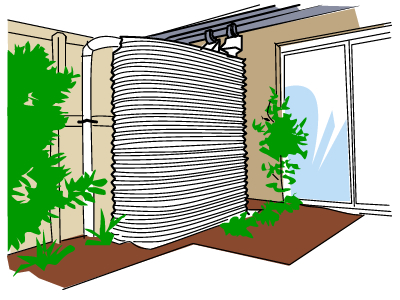
Stormwater drainage requires rainwater that comes off the roofs of buildings and paved or unpaved areas to be managed, and directed as necessary to storm water drains, or other appropriate outlets or storage areas. It's a plumber's job to design a stormwater drainage system for your home that prevents flooding, and also prevents contaminants from entering stormwater catchment systems.
The flow of the rainwater is typically off roofs, down drainpipes, through ground drainage, into underground pipes or other drainage systems and eventually into stormwater discharge drains. Some houses also make use of storage systems like rainwater tanks - these are particularly useful and common in rural areas where access to the main water supply network is limited, or where water restrictions are in place (like in Melbourne).
How is storm water collected?
Stormwater is collected from a number of sources:
- Roof water - In built up areas, this needs to be carefully managed to make sure the storm water goes where it should. The size of your roof, the intensity of the rainfall in your region, and the size of the downpipes are all factors that affect how roof water needs to be managed.
- Surface water - This is water that travels over paved or unpaved areas on the ground. To manage surface water, the specific types of surfaces and the contour and fall of the ground surface need to be taken into account. Soil areas and gardens, for example, are considered to be 'pervious' - and will absorb the water, whereas concrete is 'impervious'.
- Subsoil water - Water trapped in water-bearing ground is referred to as subsoil water. Subsoil water might flow from an adjoining property up a hill, can be trapped behind a brick wall and its foundations, or may collect at a low spot on your property. Where subsoil water is an issue, it's managed using a subsoil drain - an underground drain that collects water into a stormwater drain.
Stormwater systems
Once storm water is collected, it's then transported to a suitable outlet where it can be channelled away or stored for use in the future. This is dealt with in one of three ways:
Gravity fed systems - Drainage pipes are strategically positioned and angled so that the stormwater's fed down through to the drainage system using the pull of gravity. The sizes of the pipes will depend on how large an area rain is being collected from, and how intense the rain gets in your region.
Pump-based systems - Pumps might be necessary when your land doesn't provide a sufficient slope to allow gravity to do the job alone. Pumps are also often used in systems that incorporate rainwater tanks.
Stormwater discharge and harvesting - Large stormwater pipes and channels in populated areas transport stormwater directly into rivers, lakes (sometimes man-made) and into the sea. Sadly, this often leads to pollution and wastage of otherwise fresh water.
Stormwater storage
It's becoming increasingly common to collect rain water for re-use - either in the garden, or treated for domestic use. Water restrictions in recent years, and a general push towards sustainability and self-sufficiency have led to a big increase in the number of people installing domestic tank systems, even if only to water their plants with.
Another way rainwater can be stored for reuse is to collect it and return it to aquifers - the large underground water catchment areas people sometimes use for bore water.





